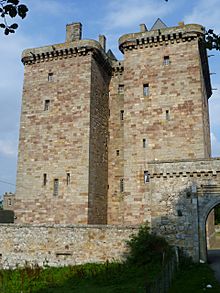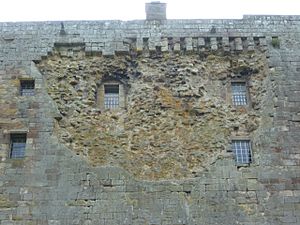Borthwick Castle facts for kids
Quick facts for kids Borthwick Castle |
|
|---|---|

Borthwick Castle
|
|
| Coordinates | 55°49′36″N 3°00′27″W / 55.8267°N 3.0074°W |
| Type | Castle |
| Height | 90 feet (area - battlements) |
| Site history | |
| Built | 1430 |
| In use | 1430-? |
Borthwick Castle is a really old and well-preserved castle in Scotland. It's one of the biggest medieval castles still standing today.
It's located about 12 miles (19 km) south-east of Edinburgh. The castle sits near the village of Borthwick on a hill. This hill makes it naturally protected on three sides. Sir William Borthwick built it in 1430, and that's where the castle gets its name. You can even see great views of the castle from the Borders Railway train!
Contents
The Castle's Early Days
Borthwick Castle was built where an older structure once stood. It has always been the family home for the Borthwick family. In 1430, King James I gave Sir William Borthwick special permission to build a castle. This was unusual because most nobles didn't need permission to build castles in Scotland.
The castle was originally a strong stone fortress. It had a very tall tower house with walls up to 14 feet (4.3 meters) thick. The tower itself was about 110 feet (33.5 meters) high. The castle is shaped like a 'U', with a 12-foot (3.7-meter) gap between its two towers. There was also a defensive courtyard around the castle.
Famous Visitors and Battles
Mary, Queen of Scots at Borthwick
Mary, Queen of Scots visited Borthwick Castle several times. In 1567, she married James Hepburn, 4th Earl of Bothwell. Soon after, they came to Borthwick Castle. They were then surrounded by enemies who wanted to capture them.
It's said that Mary escaped the castle by dressing up as a page boy. A page boy was a young servant. However, she was later captured and taken to Loch Leven Castle. Bothwell fled to other countries.
Attack by Oliver Cromwell
In 1650, the castle faced an attack from Oliver Cromwell's army. Cromwell was a powerful English leader. His forces attacked Borthwick Castle with cannons. The castle surrendered after only a few shots. You can still see the damage from this attack on the castle walls today.
Restoration and Modern Use
After being empty for some time, Borthwick Castle was repaired by 1914. During World War II, the castle was used as a secret hiding place. Important national treasures were kept safe there.
In 1973, the Borthwick family leased the castle. It was then turned into a special place for events. In 2013, the castle closed for major renovations. It reopened in 2015 as a venue for weddings and other events.
Inside the Castle
Borthwick Castle is a double tower structure. It is 74 feet (22.6 meters) long, 68 feet (20.7 meters) wide, and 90 feet (27.4 meters) high. The castle sits on a small hill with a stream around it.
The walls are made of fine sandstone and are mostly complete. It's rare that none of the original narrow windows have been made larger. The top parts of the walls, called battlements, are not as tall as they used to be. The tower has two doorways. One is at ground level and leads to the kitchen and storage areas. The other is on the first floor and leads directly into the Great Hall.
The Great Hall
The Great Hall at Borthwick Castle is 40 feet (12.2 meters) long and very tall. It has a curved, Gothic-style ceiling. This ceiling is painted with pictures of the castle. You can also see the words 'De Temple of Honor' in old Gothic writing. The large fireplace in the hall also has interesting designs.
See also
 In Spanish: Castillo Borthwick para niños
In Spanish: Castillo Borthwick para niños




